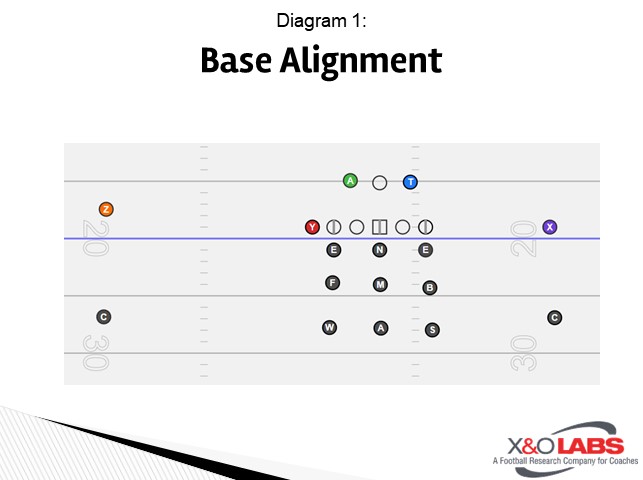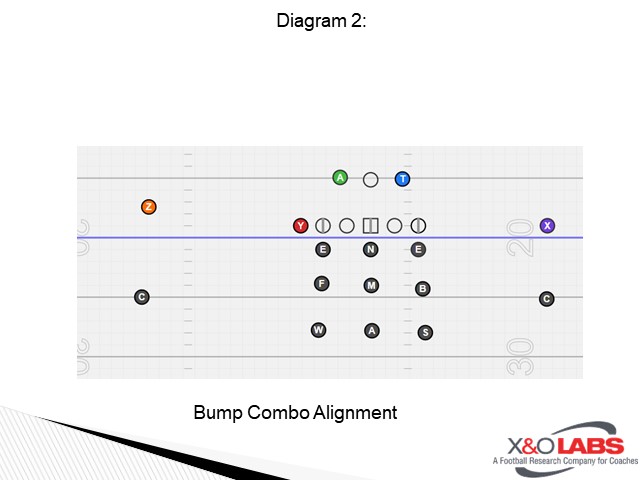By Jeff Zerfas
Safeties Coach
Northside High School (GA)
Twitter: @zerfas_atc
With the use of 3-high safety defenses becoming more prevalent at the high school, collegiate and professional levels, many coaches have asked what kind of coverages they can run within this scheme. Our answer is to run a coverage that combined many facets of our other coverages into our 3-high covers. Combo coverage involves man and zone principles and is played with the Middle of the Field closed. Combo coverage is a coverage meant to be run on 1st or 2nd down that allows the maximum number of defenders playing the run and pass at the same time. The 3-3-5 is designed to be able to bring 3/4/5/6-man pressures and combo coverage lends itself to being able to be paired with any pressure package that you want to run. Combo coverage is unique that in its base call, all 5 secondary players align at 7 yards and it stresses the opposing QB to identify who is and is not in the box pre-snap.

Base Structure/Alignment
Our base defensive structure is a 3-3-5 with a base alignment of 3 Safeties stacked over 3 Linebackers stacked over 3 DL. Our base defense strength is called to the field and we flip our 2 LBs and Safeties on each play. Our position names are F= Field Backer, B= Boundary Backer, W= Wide Safety, S= Short Safety, M= Mike, A= Adjuster. The Field Backer and Wide Safety always align to the field and the Boundary Backer and Short Safety always align to the boundary.

Alignment of Secondary Players:
Combo Coverage can be called and played 3 different ways but the only alignment/technique that changes is the corners. The base call of Combo aligns the Corners and Safeties at 7 yards. The corners are playing “Loose Man” on #1 Wide and Short Safeties are playing “Seam” Technique on 2/3, the Adjuster is “Run Support/MOF”, and the Linebackers are playing “Hug” Technique on #3.
Bump Combo:
The first adjustment that can be made is to call “Bump Combo” and this changes the alignment of the corners and brings them from 7 yards off the line of scrimmage to 5. It also changes how they play man coverage.

Press Combo:
The second adjustment we can make in Combo is “Press Combo”. This changes the alignment of the corners from 7 yards off LOS and brings them down to the LOS and they play in your face man to man coverage.
Techniques:
Corners: (Corners are 10 and 11 to the ball on run and have no responsibility to stop run)
Loose Man: Align 7 yards from LOS inside eye of #1 WR. On the snap of ball will take 3 backpedal read steps reading the release of the WR. If WR breaks at any point during 3 backpedal put foot in-ground and drive on break. If WR runs vertical, then collision inside the hip of WR and force them towards the sideline. The points of emphasis with the corners in loose man are to really work with them on getting good to backpedal steps that are not too short but are not too long. If the corner steps to close together on his backpedal, he will get to his third backpedal step before the WR has gotten to their route break. If the corner takes too long of a stride in his backpedal, he will be off-balance and will not be able to react quickly to quick game concepts.
Bump Man: Align 5 yards from LOS and head up on WR. On the snap of ball buzz feet and wait for the WR to come to you. Collision the WR at 5 yards and attempt to reroute him away from his intended route. In bump man, the corner is going to chop his feet on the snap and mirror the release of the WR. If the WR steps out the corner will side shuffle out, and if the WR steps in the corner will shuffle in, these do not have to be big shuffles the corner just needs to stay square and in front of the WR.
It is also important to work with the corner so that they do not try to put too much into their jams. Most high school corners think that they need to jam the WR hard to get a reroute and that is not what is needed in this instance. The corner forces the WR to reroute himself by simply not moving out of the way as the WR runs up the field.
Press Man: Align at LOS head up on WR. At the snap of the ball mirror release of WR and offhand jam him as he steps toward you. For the press man technique, the area that needs to be emphasized the most is that the corner does not try to be overly physical on the jam. Most corners will try to jam hard because that is what they think is important. We found that this puts the corner out of position for the rest of the route that the WR will run. We teach our corners in press man to “inch out”. This means that they will take small steps backward almost a back-ward shuffle and when the WR steps one direction the corner will then punch with the hand opposite of the step by the WR. This does not need to be a very hard punch, but it does need to be firm.
Safeties:









